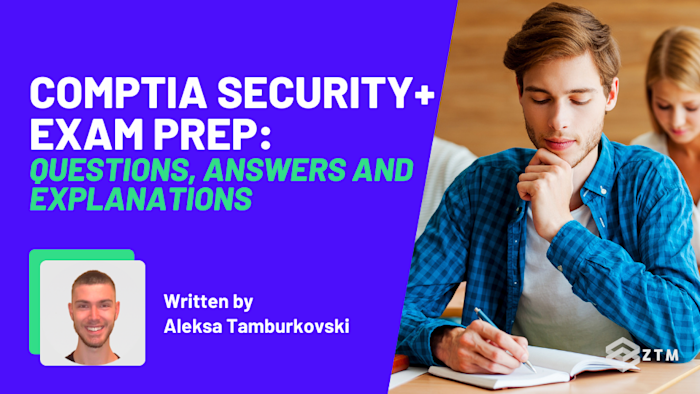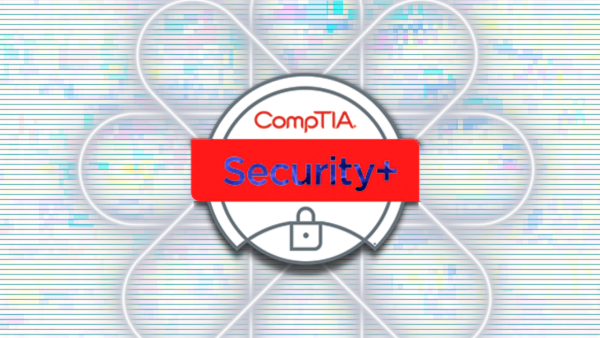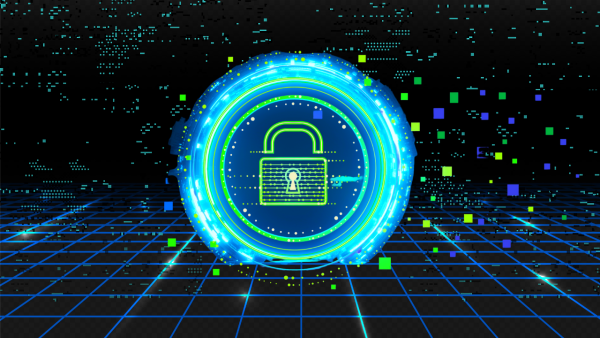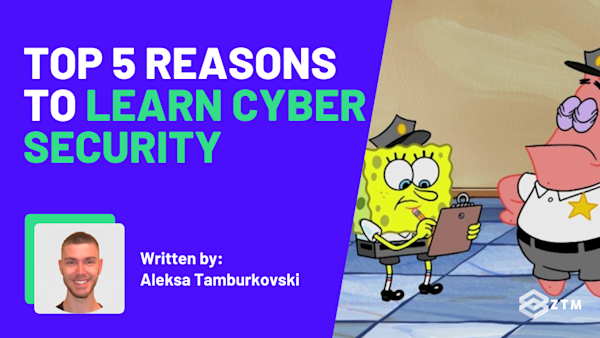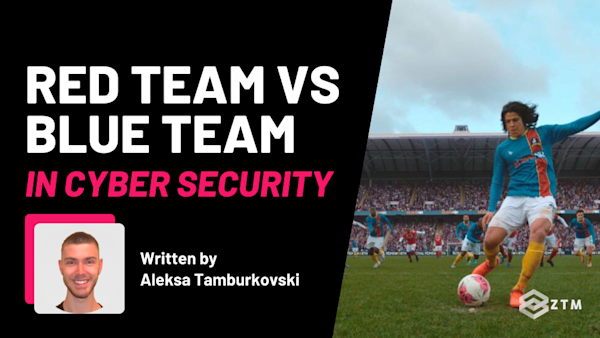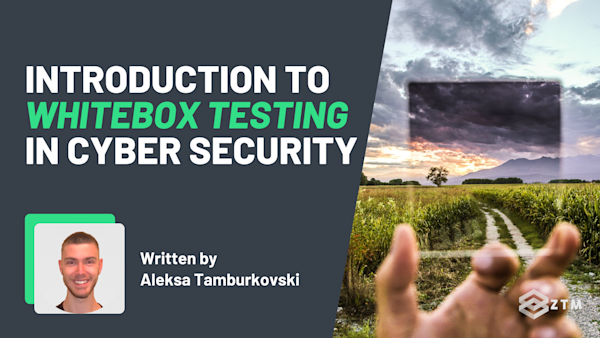Want to pass the CompTIA Security+ exam but not sure where to start?
Well, good news!
In this guide I break down 30 realistic practice questions, based on the 5 core areas that the exam covers:
General Security Concepts
Threats, Vulnerabilities, and Mitigations
Security Architecture
Security Operations
Security Program Management and Oversight
I’ve prepared 6 practice questions for each domain, so that you get some experience in each area. Better still, each question comes with the correct answer and a short explanation to help you understand why it’s right, so you can ace this topic in your exam, even if it’s worded differently.
Try them out, see how many you get right, and take the first step toward getting certified!
Sidenote: Want even more prep? I cover everything to pass this exam in my complete CompTIA+ Security Certification Exam course:
You'll learn the latest best practices and how to pass the exam so that you can springboard into your Cybersecurity career. No previous knowledge required.
With that out of the way, let’s get into the first section.
General security concept questions
This section of the exam is designed to focus on foundational cyber security ideas and concepts. It’s there to make sure you understand the core principles the rest of the exam builds on.
Question #1. Which of the following best describes the goal of the CIA triad in cybersecurity?
A) Compliance, Investigation, Authorization
B) Central Intelligence Access
C) Confidentiality, Integrity, Availability
D) Control, Identity, Authentication
Answer: C) Confidentiality, Integrity, Availability The CIA triad is one of the first things you’ll learn in cybersecurity, and it outlines the three key goals of any secure system:
Confidentiality: keeping information private and protected from unauthorized access
Integrity: ensuring information remains accurate and unaltered
Availability: making sure information and systems are accessible when needed
The reason this question matters is that every security control from encryption, access restrictions, firewalls, backups, etc.is trying to protect one (or more) of these three pillars. So if you can always tie a tool or process back to how it protects confidentiality, integrity, or availability, you’ll be thinking the way CompTIA wants you to think.
Look for clues like:
“Prevent unauthorized access” → confidentiality
“Detect if data was changed” → integrity
“Ensure systems stay online” → availability
So any time the exam asks about the purpose of a security measure, ask yourself: which part of the CIA triad is it protecting?
Question #2. An administrator wants to make sure employees can verify whether a file has been altered. Which security principle does this support?
A) Confidentiality
B) Availability
C) Integrity
D) Non-repudiation
Answer: C) Integrity
Integrity is about making sure data hasn’t been tampered with, either accidentally or by an attacker.
So if a system or document has integrity, that means it’s still in its original, trusted state.
For example
If you download a file from a vendor and compare its hash to what they published, you can confirm it hasn’t been modified along the way.
So anytime you see wording like:
“detect changes”
“verify a file’s authenticity”
“check if a message was modified”
…it’s pointing you toward integrity. Keep that principle locked in and you won’t get tripped up by trickier wording.
Question #3. Which of the following is considered a ‘technical’ control?
A) Security awareness training
B) Firewall rules
C) Locked server room
D) Mandatory vacation policy
Answer: B) Firewall rules
Technical controls are protections that are implemented through hardware or software.
So, when you see a question asking for a technical control, look for something the system is enforcing on its own without relying on human behavior .i.e. if it’s automated and based in code or configuration, it’s a technical control.
In this case, a firewall rule is a textbook example, because it filters network traffic based on pre-defined criteria like IP address, port number, or protocol, and it’s enforced by a system, and not a person.
Question #4. Which of the following best defines risk in the context of cybersecurity?
A) A known vulnerability in a system
B) The chance of a threat exploiting a weakness
C) A data breach that already occurred
D) An organization’s overall security policy
Answer: B) The chance of a threat exploiting a weakness
You’ll see this concept pop up in questions about business impact analysis, risk mitigation, and security planning. If a question is asking about “what could go wrong” or “how likely is this scenario to occur,” you’re dealing with risk.
In cybersecurity, risk is about the likelihood that something bad could happen, or more specifically, the chance that a known or unknown threat might exploit a vulnerability and cause damage.
It’s important to remember though that risk isn’t the same as the threat itself, or the vulnerability. It’s the combination of both.
For example
A system with an unpatched software flaw has a vulnerability. If an attacker has a known method of exploiting that flaw, there’s now a threat. The risk is how likely that threat is to succeed and how bad the outcome would be if it did.
Question #5. Who is responsible for deciding who can access specific data in an organization?
A) Custodian
B) User
C) Owner
D) Auditor
Answer: C) Owner
In any organization, the owner of a resource, whether it’s a file, database, or system, is responsible for deciding who should have access to it and under what conditions. They don’t necessarily configure the access themselves, but they set the rules.
For example
Think of it like sharing a Google Doc. You might be able to view or even edit the document, but only the owner can change who else gets access. That’s how it works in a company too: the owner determines who gets permission, and the custodian or IT team enforces it.
This is a key distinction in cybersecurity. The person who uses or manages a resource isn’t always the one who decides access. That’s why this question comes up often in topics related to roles and responsibilities, especially when the exam wants you to differentiate between owner, custodian, and user.
If you see a question about access approval or access authority, think of the owner as they’re the one calling the shots on permissions.
Question #6. Which concept ensures that users only get the access they need to perform their job?
A) Defense in depth
B) Least privilege
C) Separation of duties
D) Need to know
Answer: B) Least privilege
The principle of least privilege means giving users only the minimum level of access they need to do their job, and nothing more. This reduces the chance of accidental damage, internal abuse, or escalation if an account gets compromised.
For example
If someone in HR only needs access to employee records, there’s no reason they should have access to network configuration tools or financial data. Limiting access in this way contains risk and keeps sensitive systems isolated.
This concept shows up everywhere in real-world security with permissions, user roles, admin rights, and API keys, and it’s one of the most common principles tested on the Security+ exam.
You’ll often see it phrased in different ways:
“Restricting access to required systems”
“Limiting permissions to only what’s needed”
“Preventing users from having unnecessary privileges”
If the question is about controlling or limiting access based on job role, it’s almost always pointing to least privilege.
Threats, vulnerabilities, and mitigations questions
This section of the exam tests your ability to recognize different types of threats, that you understand how vulnerabilities are exploited, and know how to defend against them.
It’s designed to make sure you can think like an attacker but respond like a security professional.
Question #1. What type of attack tricks users into revealing sensitive information by pretending to be a trusted source?
A) Phishing
B) Spoofing
C) Tailgating
D) Brute force
Answer: A) Phishing
Phishing is a form of social engineering that relies on deception rather than technical exploits. The attacker poses as someone the victim trusts such as a bank, co-worker, or system administrator and convinces them to click a link, open an attachment, or provide login credentials.
You’ll often see phishing described as happening through email, but it can also happen over text (smishing), phone calls (vishing), or fake websites. What makes phishing unique is that it relies on human error, not code vulnerabilities.
If a question describes an attacker pretending to be legitimate and trying to trick someone into sharing information, clicking a link, or downloading something, you’re likely looking at phishing.
Question #2. An attacker sends a massive number of login attempts using a list of common passwords. What kind of attack is this?
A) Dictionary attack
B) Brute force attack
C) Credential stuffing
D) Password spraying
Answer: B) Brute force attack
A brute force attack is when an attacker tries every possible combination of characters or passwords until they find the correct one. It’s one of the oldest and simplest forms of attack, but it’s still relevant today, especially against weak or default passwords.
In real-world scenarios, brute force attacks are often automated and can be directed at login pages, encrypted files, or even Wi-Fi networks. They can be fast or slow, depending on how they're configured and what kind of defenses are in place.
If a question describes guessing passwords by sheer volume or repetition, and it doesn’t mention a specific list of real passwords (like in a dictionary attack), then brute force is the answer you’re looking for.
Question #3. What type of vulnerability exists when an application doesn’t properly check user input before processing it?
A) Race condition
B) Insecure deserialization
C) Buffer overflow
D) Input validation error
Answer: D) Input validation error
An input validation error happens when an application accepts input from a user but doesn’t check or sanitize it before using it in a command, query, or process. That opens the door for attackers to inject malicious data such as SQL commands, script tags, or unexpected file paths.
Input validation errors are behind many of the most common and dangerous attacks, including:
SQL injection
Cross-site scripting (XSS)
Command injection
If a question mentions an app taking in user data and failing to validate or filter it properly, you’re dealing with an input validation issue. It’s one of the core causes behind injection-based attacks, and something you’re guaranteed to see on the exam.
Question #5. What is the purpose of patch management in reducing vulnerabilities?
A) To monitor system logs for unusual activity
B) To update antivirus definitions regularly
C) To ensure known security flaws are fixed in a timely manner
D) To test backups before a disaster occurs
Answer: C) To ensure known security flaws are fixed in a timely manner
Patch management is the process of keeping systems up to date by applying security patches, bug fixes, and performance updates. When a software vendor discovers a vulnerability, they usually release a patch to fix it. The longer that patch isn’t applied, the longer your system is exposed to known threats.
Unpatched vulnerabilities are one of the most common attack vectors in real-world breaches. This is why the exam emphasizes timely patching because waiting even a few days or weeks can make the difference between staying secure or getting compromised.
If the question is about reducing known vulnerabilities, look for anything related to patching or updating software as your answer.
Question #6. What kind of security control is designed to detect or block malicious traffic at the network perimeter?
A) Antivirus
B) Intrusion prevention system (IPS)
C) Security policy
D) Backup solution
Answer: B) Intrusion prevention system (IPS)
An Intrusion Prevention System (IPS) is a type of network security control that actively monitors traffic and takes action to block threats in real time. It sits just inside or alongside a firewall and is designed to detect patterns that match known attacks, suspicious behavior, or policy violations, and then stop them before they reach internal systems.
Unlike an IDS (Intrusion Detection System), which only alerts you to potential threats, an IPS can automatically block malicious traffic, drop packets, or disconnect suspicious sessions.
If a question is asking about detecting and preventing threats at the network level, (especially with an active response), it’s pointing to an IPS.
Security architecture questions
This section focuses on how security is built into systems, networks, and environments.
It’s designed to test whether you understand how systems are structured and how to design them with security in mind.
Question #1. What is the main purpose of network segmentation in a secure architecture?
A) To improve wireless signal strength
B) To separate systems based on trust levels and reduce attack spread
C) To simplify data backup and recovery
D) To reduce latency between devices
Answer: B) To separate systems based on trust levels and reduce attack spread
Network segmentation means breaking a network into smaller, isolated sections called segments or zones, based on function, risk, or trust level. The goal is to contain threats and prevent an attacker who compromises one area from moving laterally across the entire network.
For example
You might separate your internal HR systems from public-facing web servers. That way, if a web server is compromised, the attacker can’t easily reach sensitive employee data.
On the exam, if you see a question about limiting the impact of a breach or isolating high-risk systems from the rest of the network, network segmentation is what they’re testing.
Question #2. Which security feature ensures that only authorized devices can connect to a network?
A) VPN
B) MAC filtering
C) Firewall
D) IDS
Answer: B) MAC filtering
MAC filtering is a network access control method that uses the unique Media Access Control (MAC) address of a device to determine whether it’s allowed to connect. It's often used on wireless routers or switches to create a list of approved (or blocked) devices.
While it's not foolproof, (because MAC addresses can be spoofed), it does provide a basic layer of access restriction, especially in small networks or as part of a larger layered defense strategy.
If a question is about controlling which devices can connect and not users, but actual devices, then MAC filtering is the concept being tested.
Question #3. What is the main security benefit of using a demilitarized zone (DMZ) in network design?
A) It allows unrestricted access to internal systems
B) It encrypts all internal network traffic
C) It isolates publicly accessible services from internal systems
D) It hides IP addresses from the public internet
Answer: C) It isolates publicly accessible services from internal systems
A DMZ (Demilitarized Zone) is a section of the network that sits between the public internet and an organization’s internal network. It typically hosts public-facing services such as web servers, email gateways, or DNS servers that need to interact with external users but shouldn’t expose the rest of the internal infrastructure.
The DMZ acts like a buffer zone. Even if one of those public-facing servers is compromised, the attacker still has to get through another layer of defense before reaching anything sensitive.
So if the exam asks about placing internet-facing services somewhere without risking internal systems, or about reducing the impact of a breach, DMZ is your answer.
Question #4. Which of the following protocols is most secure for remote administrative access?
A) Telnet
B) FTP
C) SSH
D) HTTP
Answer: C) SSH
SSH (Secure Shell) is the go-to protocol for secure remote access, especially when administering servers or networking equipment. It encrypts all traffic between the administrator and the remote system, protecting credentials and session data from eavesdropping or tampering.
Older protocols like Telnet or FTP send data, (including usernames and passwords), in plaintext, which makes them vulnerable to interception. SSH was designed as a secure replacement for these.
If a question mentions remote access, administration, or secure command-line control, and you're choosing between protocols, SSH is almost always the correct answer.
Question #5. What is the purpose of a jump server (or jump box) in a secure network architecture?
A) To host public web services
B) To scan endpoints for malware
C) To act as a controlled gateway for administrative access
D) To store encryption keys
Answer: C) To act as a controlled gateway for administrative access
A jump server is a hardened, isolated system that admins use to connect to other secure or sensitive systems. Instead of giving direct access to critical servers, you require users to first log into the jump server with multi-factor authentication and logging enabled, before they can go further.
Think of it as a security checkpoint that limits where administrative traffic comes from and adds another opportunity to monitor or block suspicious activity.
If the exam mentions limiting admin access, monitoring privileged sessions, or enforcing a single entry point into sensitive systems, the concept they’re testing is usually the jump server.
Question #6. Which type of cloud deployment offers the most control over security configurations?
A) Public cloud
B) Private cloud
C) Hybrid cloud
D) Community cloud
Answer: B) Private cloud
A private cloud is either hosted internally or by a third party exclusively for one organization. Because it isn’t shared with other tenants, the organization has far more control over how infrastructure is secured, configured, and maintained.
This setup allows for custom security policies, internal auditing, and tighter regulatory compliance, making it ideal for industries like healthcare or finance where full control is a must.
If a question asks about maximum control, custom security settings, or regulatory environments that require isolation, then private cloud is the answer to watch for.
Security operations questions
This section focuses on how security is enforced day to day. It covers operational procedures, monitoring, logging, automation, and how to detect and respond to potential incidents.
In other words, this is where theory meets real-world execution.
Expect scenario-based questions that test whether you know how to apply security best practices in environments that are constantly changing, while still maintaining visibility and control.
Question #1. What is the primary purpose of a SIEM in a security operations center?
A) Blocking malicious traffic
B) Encrypting sensitive data
C) Collecting and analyzing security logs
D) Controlling user permissions
Answer: C) Collecting and analyzing security logs
A SIEM (Security Information and Event Management) system gathers logs and alerts from across your entire infrastructure such as servers, firewalls, antivirus, authentication systems, and then correlates them to detect patterns that might indicate a threat.
For example
A SIEM might notice that a user logged in from two distant locations within minutes, or that a certain account is triggering a high number of failed logins. These patterns are hard to catch manually, especially at scale, which is why SIEMs are critical in modern security operations.
If a question asks about log aggregation, real-time alerting, incident detection, or correlating events, SIEM is the answer you’re looking for.
Question #2. What’s the main benefit of using automation in security operations?
A) It eliminates the need for a security team
B) It guarantees compliance with all regulations
C) It reduces response time and human error
D) It prevents all types of cyberattacks
Answer: C) It reduces response time and human error
In security operations, automation helps streamline repetitive and time-sensitive tasks, such as isolating a compromised endpoint, sending alerts, or applying patches. This doesn’t replace your team, but it does free them up to focus on complex threats that actually need human judgment.
The biggest win from this is consistency, because automated tools don’t forget steps, get tired, or miss alerts. They act fast and follow defined procedures exactly, helping reduce both incident response time and the chance of manual mistakes.
If the question mentions speeding up response, reducing manual intervention, or improving consistency in handling alerts, automation is the core concept being tested.
Question #3. Which of the following describes the process of establishing a baseline of normal activity to help detect anomalies?
A) Vulnerability scanning
B) Signature-based detection
C) Behavior-based monitoring
D) Penetration testing
Answer: C) Behavior-based monitoring
Behavior-based monitoring is all about learning what “normal” looks like in a system, such as typical user login times, regular traffic patterns, or standard CPU usage. Once that baseline is set, deviations from it can raise flags.
For example
If an employee typically logs in between 9 a.m. and 5 p.m. but suddenly accesses sensitive data at 3 a.m., that’s an anomaly. Behavior-based tools notice patterns over time and help security teams spot unusual activity that might otherwise go unnoticed.
If a question mentions learning patterns, detecting unexpected behavior, or flagging anomalies, behavior-based monitoring is likely the answer it’s pointing toward.
Question #4. What’s the main purpose of log retention policies in a security program?
A) To reduce storage costs
B) To make audits easier and support investigations
C) To ensure employees are productive
D) To prevent malware infections
Answer: B) To make audits easier and support investigations
Log retention policies define how long security logs should be stored and when they should be deleted. These policies are essential because logs can provide critical evidence during audits, security reviews, and investigations after an incident.
For example
If a breach is discovered weeks after it happens, the logs can help reconstruct what occurred, who was involved, and how the attacker got in. If the logs were deleted too early, that window into the past is gone.
So if a question mentions forensics, incident response, or compliance requirements, it's usually pointing to the value of a solid log retention strategy.
Question #5. A security analyst wants to detect unauthorized changes to critical system files in real time. Which tool should they use?
A) SIEM
B) DLP
C) HIDS
D) NAC
Answer: C) HIDS (Host-based Intrusion Detection System)
A Host-based Intrusion Detection System (HIDS) monitors individual systems (like servers or workstations) for signs of suspicious activity. One of its key features is detecting unauthorized changes to files, such as modified system binaries, unexpected new executables, or altered configuration files.
It works by comparing the current state of key files against known-good baselines (often using hashing). If anything changes that shouldn’t, the system alerts the security team.
So anytime you see a question about detecting file-level changes or monitoring system integrity on a host, HIDS is likely the right answer.
Question #6. During an incident response process, who is primarily responsible for containing the threat and preventing further damage?
A) Legal team
B) Forensics analyst
C) Incident handler
D) Executive sponsor
Answer: C) Incident handler
Incident handlers are the frontline responders during a security event. Their job is to take immediate action to contain the threat. Whether that’s isolating an infected system, blocking malicious traffic, or disabling compromised accounts, so that the damage doesn’t spread.
This role is different from analysts who may investigate logs or forensics teams who gather evidence. The incident handler is focused on rapid containment and mitigation, and is often working off a predefined incident response playbook.
So if a question mentions things like “responding quickly,” “preventing escalation,” or “executing the containment plan,” it's testing whether you know the role of the incident handler. Think of them as the people who jump into action the moment something goes wrong.
Security program management and oversight questions
This final section covers the policies, procedures, and governance structures that support an organization’s security strategy.
The goal here is to test whether you understand how security fits into the bigger picture: business needs, legal obligations, and ongoing accountability.
Question #1. What is the main goal of separation of duties in a security program?
A) Allowing employees to multitask across departments
B) Preventing a single person from having too much control
C) Improving performance reviews by assigning more tasks
D) Minimizing training costs for technical staff
Answer: B) Preventing a single person from having too much control
Separation of duties is a governance control that reduces risk by dividing tasks across multiple people. It’s about making sure no single person has enough access or authority to misuse a system without oversight.
For example
In a finance department, one person might prepare payments, but a second person must approve them. This prevents fraud or abuse, even from trusted insiders.
If you see phrasing like:
“Prevent insider threats”
“Split responsibilities”
“Ensure oversight or dual control”
…it’s likely pointing to separation of duties. The concept is especially important in roles involving sensitive access, financial authority, or admin privileges.
Question #2. Which of the following is the primary purpose of a business impact analysis (BIA)?
A) Identify potential attackers and insider threats
B) Measure the effectiveness of firewall configurations
C) Determine how disruptions affect critical business functions
D) Monitor daily system performance and uptime
Answer: C) Determine how disruptions affect critical business functions
A business impact analysis (BIA) is a foundational part of risk management and disaster recovery planning. It’s all about asking: If this system goes down, how does it affect the business? And more importantly, how long can we survive without it?
The BIA helps identify:
Which systems and processes are most critical
How quickly they need to be restored
What the financial or operational impact of an outage would be
For example
An e-commerce site might determine that if its checkout system is offline for more than 30 minutes, it’ll lose thousands in revenue. That insight shapes its recovery time objectives and backup strategy.
Anytime the exam asks about impact, prioritization, or downtime consequences, it’s testing your understanding of BIA. It’s not about preventing threats, as that comes later. This is about understanding what matters most before building protections.
Question #3. What is the main purpose of a security policy within an organization?
A) To document security incidents for forensic analysis
B) To configure firewalls and access control lists
C) To establish rules and expectations for secure behavior
D) To assign blame after a breach
Answer: C) To establish rules and expectations for secure behavior
A security policy is a formal document that outlines how an organization protects its systems, data, and users. It serves as both a guide and a rulebook, setting the expectations for how employees and contractors should behave when interacting with company resources.
For example
A policy might define:
Acceptable use of company devices
Password complexity requirements
Rules for working remotely or using personal devices
Incident reporting procedures
The point is to standardize security practices so everyone is aligned and so there’s accountability if something goes wrong. It’s not about assigning blame, and it doesn’t get into technical configuration. It’s about clear, enforceable guidance that supports the organization’s overall risk strategy.
So when the exam asks about policies, think governance, expectations, and documented procedures, and not tools or enforcement mechanisms.
Question #4. What is the primary goal of security awareness training?
A) Teach users how to write secure code
B) Prevent users from accessing unauthorized systems
C) Help users recognize and avoid security threats
D) Ensure compliance with physical security procedures
Answer: C) Help users recognize and avoid security threats
Security awareness training is one of the most important administrative controls a company can use, because even the strongest technical defenses can be undone by human error.
This training then helps employees spot phishing emails, avoid suspicious downloads, report strange behavior, and follow safe habits like locking their screens or using strong passwords.
For example
An employee trained to recognize a fake login page is much less likely to fall for a phishing attack. That single decision can stop a breach before it starts.
So when you see exam questions about reducing human risk, changing behavior, or educating users about threats, awareness training is almost always the answer. It’s about empowering people to be the first line of defense, and not a weak link.
Question #5. What is the main role of a data custodian in an organization?
A) Determining who can access sensitive information
B) Ensuring data is backed up, stored, and protected properly
C) Conducting internal audits of access logs
D) Approving user access requests based on project needs
Answer: B) Ensuring data is backed up, stored, and protected properly
The data custodian is responsible for the day-to-day management of data. That includes technical tasks like storing the data securely, performing backups, managing permissions according to policy, and ensuring it’s available when needed.
They don’t decide who gets access (that’s the data owner’s job), but they do ensure that once access is approved, it’s implemented correctly and the data remains protected.
Think of it like this:
The data owner makes the rules
The data custodian enforces and maintains those rules
So if the exam question mentions operational responsibility for protecting and maintaining data (rather than setting access policy), you’re almost certainly dealing with the custodian role.
Question #6. Which of the following best describes due care in cybersecurity?
A) Performing a backup every week
B) Purchasing the most expensive security tools available
C) Taking reasonable steps to protect systems based on known risks
D) Creating a zero-tolerance policy for insider threats
Answer: C) Taking reasonable steps to protect systems based on known risks
Due care means doing what a “reasonable” organization or person would do to prevent harm, based on the risks you’re aware of. It’s a legal and professional standard that shows you’re not being negligent.
In practice, this might include applying security patches, enforcing access controls, training staff, or following industry best practices. You don’t need to prevent every attack, but you do need to show that you took reasonable precautions given the circumstances.
When the exam asks about demonstrating responsibility or avoiding negligence, due care is likely the answer.
How did you do?
Did you get all 30 right? If so, great job! Understanding the core concepts fully will help you to pass any variations that you get.
Struggle with a few of them? That’s ok! Don’t forget, you can take my complete CompTIA+ course to make sure you can pass all 90 questions on the exam:
You'll learn the latest best practices and how to pass the exam so that you can springboard into your Cybersecurity career. No previous knowledge required.
Not only that?
If you join, you get access to every course in our library, including each of my cybersecurity courses, so you can further upskill.
Also?
You get access to our private Discord community where you can ask questions from me, other students, and other security professionals.
Best articles. Best resources. Only for ZTM subscribers.
If you enjoyed Aleksa's post and want to get more like it in the future, subscribe below. By joining over 500,000 ZTM email subscribers, you'll receive exclusive ZTM posts, opportunities, and offers.
No spam ever, unsubscribe anytime
